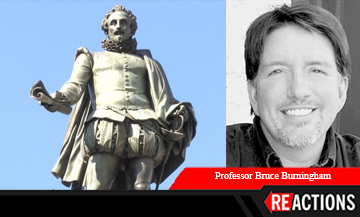With the likely discovery of the tomb of famed Spanish writer Miguel de Cervantes, Professor of Spanish and chair of the Department of Languages, Literatures, and Cultures Bruce Burningham took a moment to reflect on Cervantes’ legacy, and what it means to find the tomb of the author of Don Quixote.
Burningham:
In many ways, Cervantes is to the Spanish-speaking world what Shakespeare is to the English-speaking world. He published the first part of The Ingenious Gentleman Don Quixote of La Mancha in 1605 and the second part in 1615. Due to its worldwide success (many scholars consider Don Quixote to be the first modern novel), this two-part novel has lasted through the centuries, taking on new meaning for new generations.
In fact, Don Quixote is more than just a novel; it is also a piece of literary criticism. Cervantes critiques almost every major literary genre of his day. Think of it a bit like the way the movie Scream is a horror movie that critiques the conventions of horror movies. Don Quixote is a literary work that lays bare the constructedness of other literary narratives.
In the same way that people currently read popular authors like John Grisham or Danielle Steele, early modern readers devoured the romances of chivalry, stories filled with knights doing glorious deeds. Don Quixote is about a man who has read too many of these stories, who imagines himself a knight-errant, and who then convinces his neighbor, Sancho Panza, to go out into the world with him to perform the same kind of glorious deeds. However, instead of encountering the armies and giants that he thinks he sees, he actually attacks herds of sheep and windmills. Cervantes presents him as bumbling and foolish in the real world as a way of highlighting the artificiality of the chivalric novels.
Don Quixote is so rich and speaks to so many different people that it has meant something different to each new generation of readers. For instance, during the Romantic period (the age of writers like Lord Byron and Edgar Allen Poe), Don Quixote was honored as the epitome of the “mad genius” – so far ahead of his time that he did not belong. By the end of the 1800s, after Spain had lost the Spanish-American War (and, with it, the last of its American colonies to a young “upstart” nation like the U.S.), Spain reinterpreted Don Quixote as a metaphor for Spain’s centuries-long decline from its position as the world’s greatest super power in the 1500s. Suddenly, Don Quixote was revered as a kind of national hero because he fights the good fight, against impossible odds, and is then ennobled by his defeat because there is honor in simply having the courage to fight.
The importance of finding Cervantes’s remains is that people have always wanted to maintain a physical connection to the past. Where earlier generations, however, venerated the bones of medieval saints and other religious figures, our culture looks for ways to connect with the great canonical writers of the past few centuries. Finding Cervantes’s bones provides people with some tangible connection to the greatness of his work.
Of course, scientists are not absolutely certain that the remains they have found belong to Cervantes. Unlike the recently-discovered bones of England’s King Richard III, for which scientists could perform DNA tests to prove that they did belong to Richard, we are unlikely to find a descendent of Cervantes to whom we can compare the DNA. Still, the discovery does help stir the imagination. And that is something Cervantes has done for centuries.

